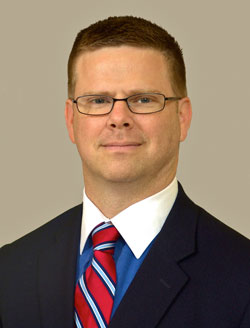
A person’s willingness to lie can be predicted with surprising accuracy through a questionnaire developed by a Longwood University faculty member who studies "deception detection."
Dr. Randy Boyle, who teaches in Longwood’s Cyber Security Center, is the co-author of a recent study that predicts 62.3 percent of the time whether someone has a "propensity to deceive." Unlike other studies on deceptive behavior, which generally focus on situation-specific factors and deceptive indicators, the study examined how attitudes and beliefs influence one’s willingness to deceive.
"Fraud, embezzlement and insider trading are a few reasons why it’s important for businesses to detect deceptive acts," said Boyle. "The survey may be useful for pre-employment screening, particularly with banks and sensitive government agencies. Using a simple survey would reduce the number of polygraph exams, which are expensive—between $350 and $650."
The study focused on assessing and predicting, through responses to questions, a person’s intention to deceive others. It found that people who are more confident in their ability to deceive others, enjoyed deceiving others, felt less guilt and felt justified in deceiving others were more likely to deceive.
"What this study says is that 62 percent of the time, we can predict a person’s general intent to deceive," said Boyle, associate professor of information systems. "Most situational studies have not been able to get above the 50 percent mark, which is guesswork. Some situational studies claim up to 74 percent, but there is no consensus in the scientific community to support these findings. The best form of detection is a lie detector, which is accurate 98 percent of the time, but it’s not always feasible to strap someone in the chair [administer the test]. The question for behavioral analysis of deception detection is—How can we get from 50 to 98 percent without using a machine? That’s what we’re trying to figure out.
"It would be cool to develop a mobile app for this. Some apps that measure voice stress have been developed, but they’re not very accurate—their ability to correctly identify lies is questionable. Science has not developed a legitimate lie detector based on behavioral cues."
Boyle’s recent study, "Predicting Deceptive Behavior: Exploring antecedents to deceptive behaviors," surveyed 450 junior and senior business majors at Florida State University (FSU), where he earned his Ph.D. and first became interested in deception detection, and the University of Utah, where he taught before joining the Longwood faculty. Boyle’s co-authors are Jeffrey Clements and Jeffrey Proudfoot, each of whom is finishing a Ph.D. in management information systems (from FSU and the University of Arizona, respectively). Clements is a research assistant to Judee Burgoon, who is considered the world’s top authority in the field of deception detection.
"This was a behavioral analysis study that sought to figure out when and in what circumstances someone is willing to deceive," said Boyle.
The study is the first part of a three-part project. In the second phase, Boyle will test Longwood students using the "prisoner’s dilemma" game—in which two hypothetical criminals, each held in solitary confinement, are given options ranging from cooperation to betrayal—with financial rewards based on their ability to deceive the other. "This will determine whether intent to deceive turns into deceptive acts," said Boyle. The final phase will employ a polygraph, or lie detector, which Boyle hopes to purchase through a grant.
"We hope the situational studies, and later the polygraph studies, will prove the validity of the survey," Boyle said.
Boyle’s doctorate focused on people’s ability to detect deception in various communication styles, including face-to-face, phone conversations and email correspondence.
"Face-to-face is a trickier medium than the other two," he said. "You put slightly less energy into analyzing a voice call and the least amount of energy into a computer chat. But face-to-face has richer cues—indications they are lying. When people deceive, they generally give shorter responses, make more speech errors—uh’s and er’s and um’s—and blink more and fidget more, and there is a slight dilation of the pupils. People lying in emails tend to use shorter sentences and what are called levelers—words like ‘everybody’ and ‘nobody.’ And they’re more negative and more intense and use words like ‘immediately,’ ‘now,’ ‘urgent.’"
People are less honest than they think are, said Boyle. "I tell students ‘See how long you can go without telling a lie or withholding information.’ Most go only about one day. I made it almost a week one time, but I offended several people at work and almost got fired! It’s best not to do this at work. I was 100 percent truthful, and when I did lie, it was job-related—I told my boss I had met a deadline that I didn’t meet. Most people are deluded into thinking they’re an honest person. Some can’t go two hours without telling a lie. Most people lie throughout the day, but they’re not big lies, and some are good—like Santa Claus and the Easter Bunny."
